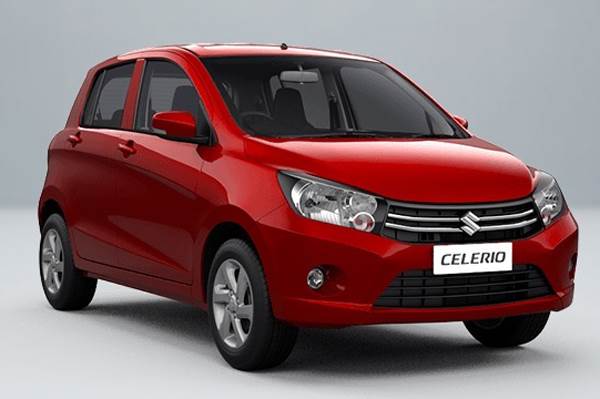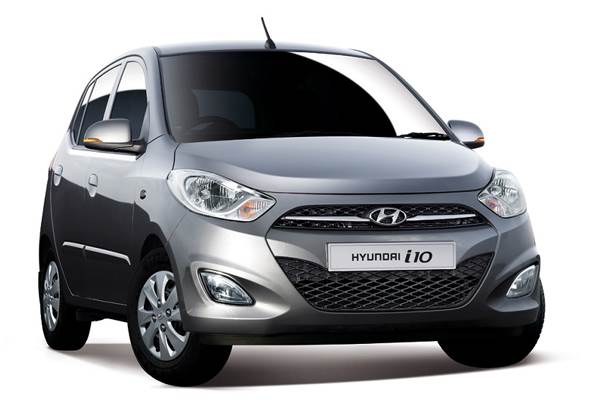A new Maruti Suzuki hatchback is always something the Indian market looks forward to, and with the Maruti Celerio launched from Rs 3.90 lakh, with an automatic version from just Rs 4.29 lakh, it sure has gotten people talking. But it’s not alone in this segment, and will have to answer to popular cars like the Honda Brio, Ford Figo and Hyundai i10. So just how does it stack up?
The basic facts first. The Maruti Celerio is only available with a petrol engine, as are the others, apart from the Ford Figo, which also gets a diesel option. The Figo and the i10 are only available with manual gearboxes, the Celerio gets a five-speed automated manual transmission (AMT), while the Brio gets a five-speed torque-converter auto.
Sticking with the powertrains, the Maruti’s is the smallest and the only three-cylinder unit here – the venerable 998cc K10 engine – although its power and torque outputs of 67bhp at 6,000rpm and 9.1kgm at 3,500rpm are respectable for its size. The Hyundai i10’s 1.1-litre, four-cylinder iRDE engine (you can’t have it with the punchy 1.2-litre Kappa2 anymore) makes not too much more, with 68.05bhp at 5,500rpm and 10.1kgm at 4,500rpm, while the Figo’s bigger, 1.2-litre motor pushes out 70.02bhp at 6,250rpm and 10.4kgm at 4,000rpm. On numbers, however, the Honda Brio really walks away with it; its 1.2-litre i-VTEC engine produces a solid 86.8bhp at 6,000rpm and 11.1kgm at 4,500rpm. Continued..
The Maruti Celerio is also offered in four trims – LXi, VXi, ZXi and ZXi (O). The manual is available in all these trims, while the automatic is only available in the lowest two trims – LXi and VXi. In contrast, the Honda Brio is available in five trims, with the automatic only available on the top VX one, which shows the contrast in the way each company is pushing its two-pedal variant; it seems Maruti really wants an automatic for the people. The manual-only i10 and Figo are available in three and four trims, respectively.
If you opt for the base manual-gearbox models, they’re all priced within Rs 30,000 of one another – the Maruti being the most affordable at Rs 3.90 lakh – and are all similarly equipped. You get the bare necessities, like power steering and air conditioning, although some of them do offer a bit extra. The Figo LXi (Rs 3.99 lakh), for instance, will get you a day/night rearview mirror, the i10 Era (Rs 4.01 lakh) comes with a tachometer and a shift indicator, while the Brio E (the most expensive at Rs 4.18 lakh) gets central locking, a tachometer and front power windows.
The middle trims of all these cars add to their base counterparts features like audio systems, rear power windows and a variety of internal and external cosmetic garnishes, among other things. But to really get a sense of what these cars can offer, it’s best to look at their top trims. Conitnued..
Amongst the manuals, the Honda Brio VX and Ford Figo Titanium are the most expensive, at Rs 5.41 lakh and Rs 5.42 lakh, respectively. Then comes the Celerio ZXi (O) at Rs 4.96 lakh, while the i10 Sportz, surprisingly, is the cheapest at Rs 4.51 lakh. All cars in their fully loaded trim get remote locking, front fog lamps, rear parcel shelves and integrated audio systems with four speakers, although the Honda Brio stubbornly does without a CD player and neither it nor the i10 get Bluetooth connectivity, which the other two get. They all have USB and aux-in support though, and the Figo Titanium now also gets in-car Wi-Fi (you have to buy a data SIM) as a Rs 10,000 optional extra. On the safety front, in these top trims, all but the Hyundai i10 get ABS and a driver airbag; the Figo Titanium and Brio VX get a passenger airbag too. The i10 Sportz misses out on steering controls as well.
Hyundai has a reputation of stuffing its cars with equipment, and so the fact that the i10 has the shortest equipment list here may be surprising. But the fact is, Hyundai has now squeezed the Grand i10 in below the i20, and so the former is left with just the basics. On the contrary, Honda doesn’t have any other hatchbacks in its line-up (for now), and so the Brio range is spread across six variants and Rs 2 lakh, giving you a lot more choice. The Figo gets a lot of kit too, but the top Titanium trim really pushes the price envelope for this class of car. Ultimately, the new Maruti Celerio does come across as the best value, even if purely on the basis of its great pricing. The lower two trims are a bit down on kit in some areas, but then, the top two trims aren’t too expensive either. The automatic in LXi (Rs 4.29 lakh) and VXi (Rs 4.59 lakh) trims represents the best value of all, although we’d have liked the option of a two-pedal Celerio with more equipment.




Comments
Member Login
Personal Details
No comments yet. Be the first to comment.